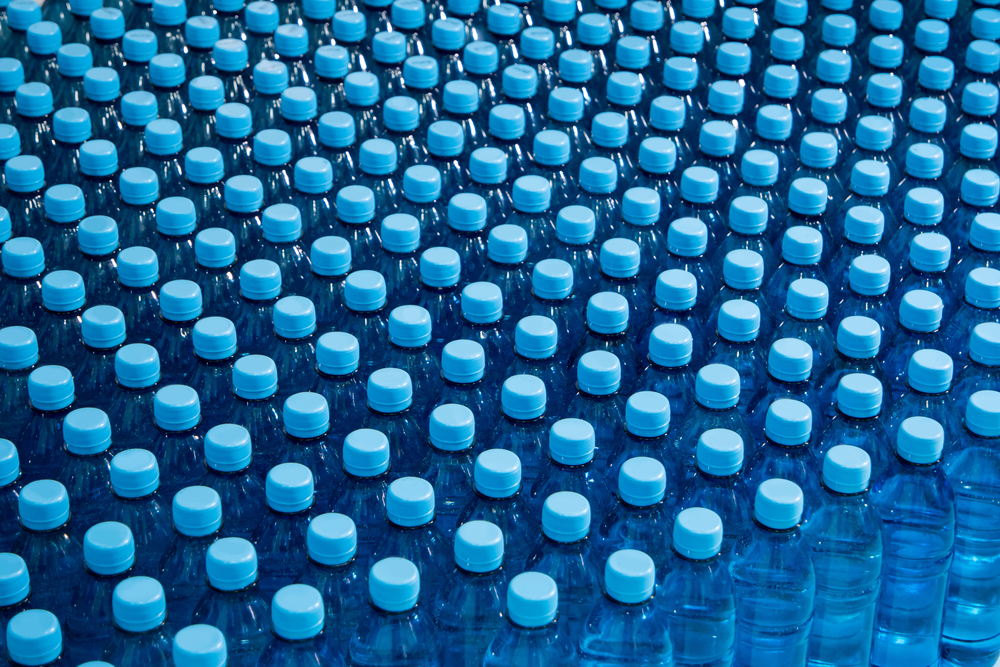When it comes to simple swaps, a few items always make the list. Some of our top single-use plastic offenders include: plastic bags; plastic bottles; plastic straws; and plastic utensils.
As purveyors of pure, healthy, clean water, there’s one plastic product that we have a big problem with: plastic water bottles. Let’s take a look at the journey they typically follow—from production to becoming problematic waste.
The Journey of a Plastic Bottle
Manufacturing
Like most other plastics, plastic water bottles are made from fossil fuels.
The majority of plastic bottles are made with what’s called polyethylene terephthalate (PET). This type of plastic (#1 on the bottle) is used for many things, like clothes and food containers. You’ll often see it referred to as LDPE or HDPE (indicating low or high density).
PET is made by creating rice-looking pellets of polymers, which are a large number of repeating chains of single units of similar materials. In this case, its main material is ethylene, which comes from petroleum and natural gas.
The pellets are melted and molded, using a combination of heat, air, and pressure. Then they’re cooled, using either air or carbon dioxide. Following that, they’re trimmed and then sent to be filled.
Not only does this require fossil fuels to make the PET plastic itself, but it also requires a significant amount of energy during every stage in the manufacturing process—to the tune of 17 million barrels of oil annually.
It’s also important to consider that the water itself also has to be treated! Both ‘purified’ and ‘spring’ water will be treated at least once, and in some cases twice, at a manufacturing plant. Treatment processes like reverse osmosis, ultrafiltration, ultraviolet radiation, and ozonation are also energy-intensive.
Finally, to clean, fill, seal, and label the bottles also requires machines that use energy.
During the production stage, pollutants like benzene, ethylene oxide, and nickel are released, making their way into the air we breathe and the water we drink.
Transportation
Before your thirst can be quenched, a bottle of water needs to make it from factory to warehouse, to retail store—which also requires fossil fuels.
For the fans of fancy water that comes from abroad, you may be drinking something that’s bottled in France or Fiji, then sometimes shipped using air cargo—which is heavily energy-intensive.
It will often arrive in Los Angeles, before again being transported (via rail or truck) to a local distributor, then eventually ending up stocked on supermarket shelves.
In addition, trucks release pollutants and contribute to smog, which negatively impacts health.
Considering just manufacturing and shipping, the energy requirements of bottled water are 2,000 times that of tap water.
And this doesn’t even take into consideration what happens after the last sip is taken!
The final sip
A disposed single-use plastic bottle typically has three fates:
Recycling Facility:
Just 29.1% of PET bottles are recycled every year in the US.
Even then, contamination and recycling complications often prevent that bottle from being properly transformed into a new product. Plastic is a material that is “downcycled,” meaning that even a perfectly recycled bottle can never become a bottle again, and instead gets transformed into a plastic bag before its unavoidable fate of ending up in a landfill.
Incinerator:
We’ll save this for another blog post, but recycling doesn’t happen nearly as often as we think. To help curb the rapid growth of landfills, waste (including plastic bottles) is often burned in incinerators. Not only does this require even more energy, but it also releases unknown levels of toxins into the environment.
This can lead to health complications like respiratory symptoms, hormonal defects, and cancer—to name just a few. Additionally, it contributes to ozone and smog formation, ocean acidification, toxins that impact animals and ecosystems, and, ultimately, global warming.
Landfill:
As the plastic bottle spends roughly 450 years decomposing in a landfill, it’s exposed to the elements. Rain mixes water with water-soluble particles creating leachate, a “toxic landfill soup.”
In other words, that plastic bottle contributes to water droplets that contain toxic chemicals like PFAS—which are ‘forever chemicals’ (because they never go away) and suspected carcinogens.
These make their way into soils and streams, harming ecosystems, wildlife, and us.
The journey is never over
In other cases, plastic bottles float away from where they’re discarded, often ending up in one of 5 ocean gyres—also known as garbage patches. Here, they will continue to release polluting chemicals that harm marine life, and ultimately other animals up the food chain (including humans).
They also release microplastics, which will persist in our environment indefinitely.
Reduce Plastic + Pure Water
Why have a habit that contributes to all of that when you can have a drink of water that’s even purer and healthier—and doesn’t come in a plastic bottle? Just one set of filters for our countertop water purifiers replaces 4,500 plastic water bottles!
The AquaTru family has already saved more than a billion single-use plastic bottles from being produced. Join us to help make that number grow.






